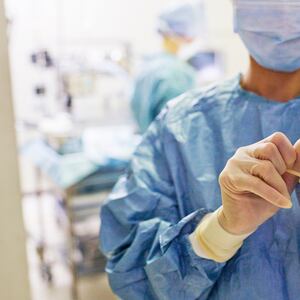On Monday, New York City moved into Phase II, allowing New Yorkers their closest sense of normalcy in months. But even though the transition to the second phase of reopening symbolizes New York City’s progress in containing the coronavirus, it doesn’t necessarily provide a reprieve from the restrictions and worries for New Yorkers.
“The reopening has not really changed how I feel,” Dior Vargas, a 33-year-old resident of Upper Manhattan, told The Daily Beast. “My assumption is to just hunker down, stay in, and see what happens next. I’m very wary of making any sudden movements.”
COVID-19 hit Vargas and her family incredibly hard. She, her sister, her mother, and both of her maternal grandparents had the virus, with the latter having to be hospitalized. “Pretty much all of April I was terrified. Every text or call I got from my mom or sister, I assumed either one of them [her grandparents] had died.”
Vargas has trouble understanding people who are ready to hit the town, especially when they are not wearing masks. “I wonder, do these people who are going out immediately and/or not wearing masks, did they not have people in their lives that they almost lost? Did they not go through this terror every single day? Is it that they did not care who among them was impacted because all they cared about was themselves, and how they couldn’t get their hair done or just plainly didn’t like wearing masks?”
Elischia Fludd, a 37-year-old living in Manhattan, told The Daily Beast that she worries “we are going to have to shut things down again” because of “the way this country is operating on a federal level,” along with the inadequate health measures she feels individual state governors have taken. As a result, despite the transition to Phase II, Fludd said, “I continue to take the same precautions.”
Pamela Grossman, 53, lives in Brooklyn and can easily recall the “wailing hospital sirens going by every day and the horrible news from every corner.”
Grossman lost two friends during the pandemic, one a confirmed case of the coronavirus and one suspected. She is amazed (and appalled) that some New Yorkers can be so cavalier. She said she recently walked by “a BBQ of 40 people, drinking, no social distancing, and no masks.” She thought, “Who are you? Did you just get to New York yesterday? Did you not hear the ambulances I heard?”
For some New Yorkers, the transition to reopening is hardly a panacea (or even a Tylenol) for their concerns.
From Vargas’ perspective, the fact that the city has reached certain benchmarks hasn’t changed her worries, especially when much is unknown about coronavirus immunity. “I feel like we can’t be too comfortable,” she said. “I’m still somewhat on pins and needles.”
In theory, reopening should bring a sigh of relief. But not only are some New Yorkers uneasy and hesitant to loosen the coronavirus restrictions, some experts note that the reopening may actually see an increase in mental health issues.
Matthew Shapiro, associate director of public affairs at NAMI (National Alliance on Mental Illness) New York State said their hotline experienced a spike in calls at the start of the pandemic, but then there was a plateau and decrease.
With the reopening, though, they are starting to see a new rise. “Initially, we were very valiant and determined to flatten the curve,” he said. “As we advanced and move forward, a whole new set of anxieties set in.”
Dr. James Murrough, associate professor of Psychiatry and Neuroscience and director of the Depression and Anxiety Center for Discovery and Treatment at the Icahn School of Medicine at Mount Sinai, said their depression center call volume has had a similar pattern.
There was an increase in calls at the start, but then the number of New Yorkers calling in dropped. “I think they were bracing and weathering the storm,” he told The Daily Beast. However, “Now, in the last several weeks, we’ve seen a substantial increase in call volume.”
Some of that may not only be attributable to fears surrounding the health effects of the virus. There’s the effect the pandemic has had on the economy, including widespread job loss. There have also been the killings of Ahmaud Arbery, Breonna Taylor, George Floyd, Rayshard Brooks, Elijah McClain and many other Black people that have had a traumatizing effect.
“We’re facing three different storms at once,” Shapiro said. “We’re dealing with COVID. We’re dealing with the economic situation. We’re dealing with all the racial injustice. This three-headed monster is really having an impact.”
There is also the fact that New Yorkers may be facing post-traumatic stress symptoms as they move out of “practical survival mode,” Murrough explained.
He compared New Yorkers’ anxieties in the wake of coronavirus improvement to the that of a solider returning to the calm and safety of home after experiencing combat. “You can tell the patient the war is over, but that doesn’t make the symptoms go away,” he said. “They still carry the primed activation response state. To one degree or another, we’re experiencing that.”
He pointed to the Sept. 11, 2001 attacks as a model for understanding the potential long-term mental health effects of the pandemic.
He stressed that over time the risk and cases of Post-Traumatic Stress Disorder (PTSD) tapered off. However, “the flipside is that to this day, there are 9/11 monitoring clinics around this city to monitor the physical and mental health effects.”
Moreover, because uncertainty is an innate part of the pandemic, it may actually make its long-term mental health effects more severe.
“Part of what perpetuates post-traumatic stress reactions is the uncertainty that another threat will happen again—and that’s what we’re in,” Murrough said. “For everybody, lingering in the back of their minds is, ‘Is there another peak? Is there a second wave coming?’ Even though the numbers look good, the uncertainty that’s inherent to the situation is fueling the anxiety.”
Dr. Anne Marie Albano, Columbia University professor of Medical Psychology in Psychiatry, told The Daily Beast that with the Sept. 11 attacks, there was “an identifiable enemy.”
In contrast, “Here, we have something you can’t see; you can’t see the droplets of virus.” Adding to the uncertainty is the fact that “the virus, unfortunately, doesn’t give us a timeline for getting back to normal.”
But some New Yorkers have already accepted that “normal” is just one of the many things that is lost to the pandemic, and the return of outdoor dining, hair salons, and department stores can’t bring it back.
“I’m reading the coronavirus is going to be part of our lives in some ways for the rest of our lives,” said Vargas. “I just feel this sadness about how the life I had before this is never going to be like that again.”







